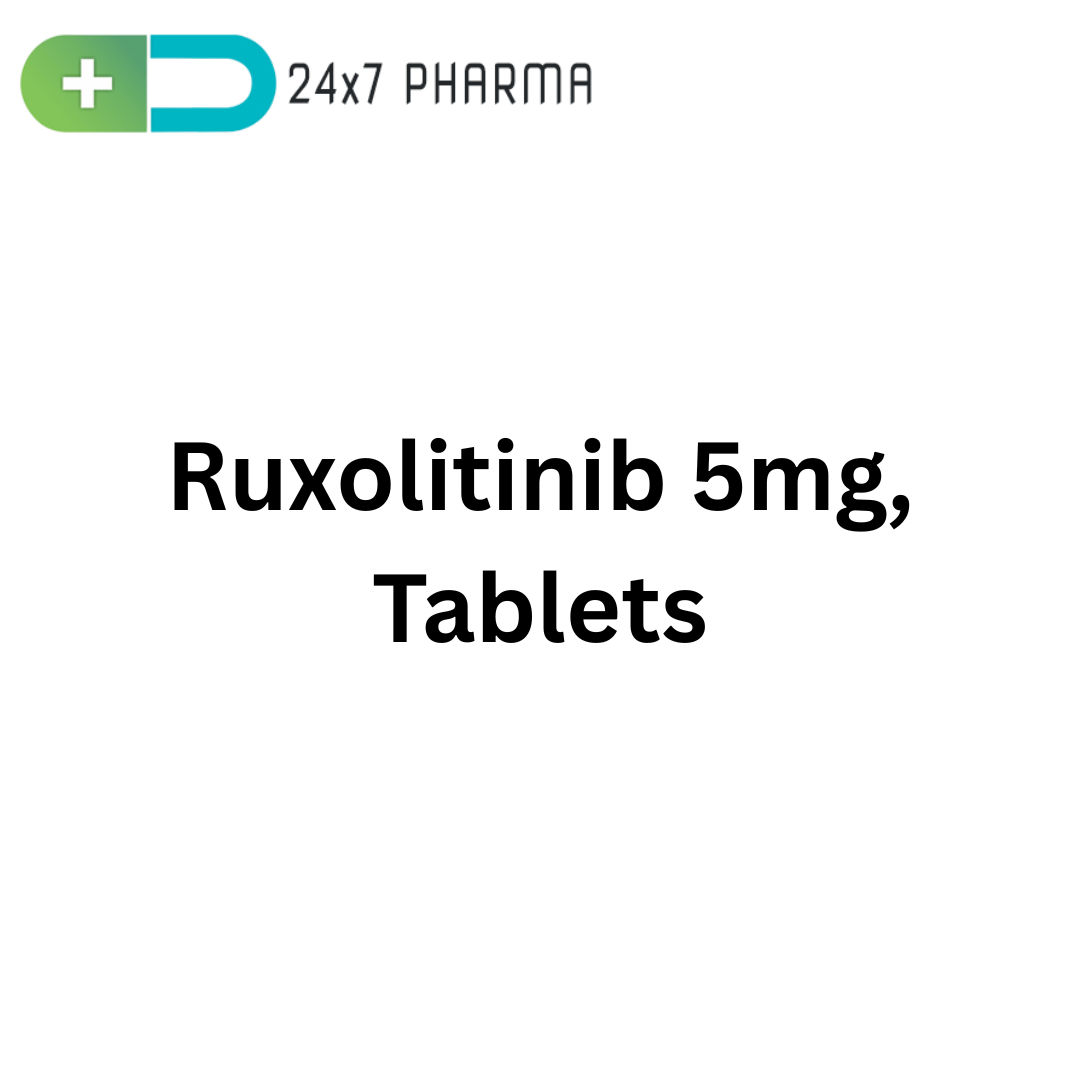LuciRux 5mg, Ruxolitinib Tablets
LuciRux 5mg is a pharmaceutical formulation containing Ruxolitinib, a selective Janus kinase (JAK1 and JAK2) inhibitor. It is mostly used to treat inflammatory diseases and hematological malignancies. This drug is designed to interfere with the abnormal cell signaling pathways involved in diseases like myelofibrosis, polycythemia vera, and certain forms of graft-versus-host disease (GVHD). LuciRux is marketed to provide symptom relief, improve quality of life, and potentially delay disease progression.
What is LuciRux 5mg (Ruxolitinib)?
LuciRux 5mg contains Ruxolitinib, an oral targeted therapy drug belonging to the class of Janus kinase inhibitors. It acts on specific enzymes (JAK1 and JAK2) that are involved in the signaling pathways controlling immune function and hematopoiesis (blood cell production). This medication is approved for conditions characterized by dysregulated JAK signaling, including:
- Myelofibrosis (MF)
- Polycythemia Vera (PV)
- Steroid-refractory Acute and Chronic Graft-Versus-Host Disease (GVHD)
How it Works / Mechanism of Action
Ruxolitinib works by inhibiting Janus-associated kinases (JAK1 and JAK2), which are key components in the JAK-STAT signaling pathway. This pathway transmits signals from various cytokines and growth factors to the cell nucleus, influencing DNA transcription and cellular response.
In diseases like myelofibrosis or polycythemia vera, mutations (such as JAK2 V617F) lead to constant activation of this pathway, resulting in excessive blood cell production, bone marrow fibrosis, and inflammation. Ruxolitinib suppresses this abnormal signaling, reducing disease-related symptoms such as:
- Splenomegaly (enlarged spleen)
- Constitutional symptoms (fever, night sweats, weight loss)
- Inflammatory cytokine release
How to Use / Indications
LuciRux 5mg is indicated for:
- Intermediate or high-risk myelofibrosis, including primary myelofibrosis, post-polycythemia vera MF, and post-essential thrombocythemia MF.
- Polycythemia vera in patients who are intolerant to or have inadequate response to hydroxyurea.
- Acute or chronic GVHD in steroid-refractory cases (FDA-approved).
- It helps manage disease burden by controlling symptoms and improving blood counts and organomegaly.
How to Take / Dosage
Standard adult dosage depends on the indication and platelet count:
For Myelofibrosis:
- Platelets ≥ 200,000/µL: 5 mg twice daily
- Platelets 100,000–200,000/µL: 15 mg twice daily
- Platelets 50,000–100,000/µL: 5–10 mg twice daily
Polycythemia Vera: 10 mg twice daily, may be adjusted based on response and tolerability
GVHD: Typically starts at 5 mg twice daily and may increase to 10 mg twice daily
Take LuciRux 5mg orally with or without food, at the same time each day. Dosage adjustments may be required in cases of renal or hepatic impairment.
Other Dosage Forms & Strengths
LuciRux (Ruxolitinib) is also available in other strengths such as:
- 5 mg
- 10 mg
- 15 mg
- 25 mg
These alternative dosages allow for titration based on patient tolerance, platelet levels, and treatment indication.
Side Effects
Common side effects include:
- Anemia
- Thrombocytopenia (low platelets)
- Neutropenia (low white blood cells)
- Headache
- Dizziness
- Bruising or bleeding
- Fatigue
- Weight gain
- Increased cholesterol levels
- Nausea and diarrhea
Serious adverse effects:
- Opportunistic infections (e.g., tuberculosis, herpes zoster)
- Liver enzyme elevation
- Progressive multifocal leukoencephalopathy (rare)
- Increased risk of non-melanoma skin cancer
- Withdrawal syndrome (worsening symptoms upon brupt discontinuation)
- Regular monitoring of blood counts and liver function is essential during treatment.
Storage
- Store LuciRux 5mg at room temperature (20°C to 25°C).
- Keep away from moisture, heat, and direct sunlight.
- Keep out of reach of children.
- Do not use if the packaging is torn or expired.
Benefits
- Symptom relief: Rapid improvement in spleen size and constitutional symptoms.
- Improved quality of life: Less fatigue, night sweats, and discomfort.
- Disease modification: Slows progression of myelofibrosis and controls erythrocytosis in PV.
- Steroid-sparing effect: Effective in managing GVHD where corticosteroids fail.
- Oral administration: Convenient and non-invasive.
Prescription
LuciRux 5mg is a prescription-only medication and must be used under the guidance of a qualified healthcare provider, preferably a hematologist or oncologist. Prescription is based on:
- Confirmed diagnosis (MF, PV, GVHD)
- Baseline and periodic blood tests
- Evaluation of liver and kidney function
- Assessment of potential drug interactions
Interactions
Ruxolitinib is metabolize by CYP3A4 and CYP2C9 enzymes. Hence, caution is require with:
Drugs that increase ruxolitinib levels (risk of toxicity):
- Ketoconazole
- Clarithromycin
- Ritonavir
Drugs that decrease ruxolitinib levels (risk of reduced efficacy):
- Rifampin
- Phenytoin
- Carbamazepine
Anticoagulants/antiplatelets: Increased bleeding risk
Due of immunosuppression, avoid live vaccinations while undergoing therapy.
Always inform your doctor of any ongoing medications or supplements.
FAQs
Can LuciRux 5mg cure myelofibrosis?
No, it doesn’t cure MF but helps manage symptoms and slows disease progression.
Can I stop taking LuciRux suddenly?
No, sudden discontinuation may lead to symptom rebound. Taper only under medical advice.
What tests are need during treatment?
Frequent CBC, liver function tests, and infection screening are essential.
Can it be use in children?
It is approved for certain conditions in pediatric populations but should only be use under expert care.
Conclusion
LuciRux 5mg (Ruxolitinib) is a potent and targeted JAK inhibitor used in the treatment of serious hematologic and immune-related disorders. It represents a major advancement in managing myelofibrosis, polycythemia vera, and graft-versus-host disease. By modulating the JAK-STAT pathway, it controls symptoms, reduces organomegaly, and enhances the quality of life for patients. However, due to its immunosuppressive nature and hematological side effects, careful monitoring and medical supervision are vital. When used appropriately, LuciRux can be a highly effective tool in the long-term management of chronic and complex conditions.




